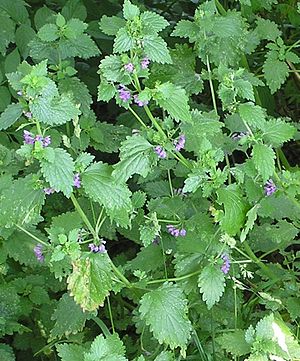Note: This is a project under development. The articles on this wiki are just being initiated and broadly incomplete. You can Help creating new pages.
Difference between revisions of "Ballota nigra - Black horehound"
(→Leaf) |
(→Flower) |
||
| Line 23: | Line 23: | ||
===Flower=== | ===Flower=== | ||
| − | {{Flower|bisexual| | + | {{Flower|bisexual|length 9–10 mm, width 7 mm|purple to withish, pink|Ovary is superior, with a single white style and a 2-parted stigma|Flower has an actinomorphic calyx, made up by five sepals fused together in a tube with five teeths}} |
===Fruit=== | ===Fruit=== | ||
Revision as of 18:12, 13 April 2018
Ballota nigra (black horehound) is a perennial herb of the family Lamiaceae. It is native to the Mediterranean region and to central Asia, and it can be found throughout Europe. It is also naturalized in Argentina, New Zealand, and the Eastern United States. It blooms in the Northern Hemisphere from May to August.
Contents
Uses
rheumatism, eye diseases, gonorrhea, diabetes, gout.
Parts Used
Chemical Composition
Ballota nigra contains diterpenoids like marrubiin, ballonigrin, ballotinone, ballotenol and 7-acetoxymarrubiin. Also, it contains phenylpropanoids that have shown to be antioxidants[1]
Common names
| Language | Common name |
|---|---|
| Kannada | āvarike |
| Hindi | Tarwar |
| Malayalam | |
| Tamil | āvārai |
| Telugu | taṃgēḍu |
| Marathi | NA |
| Gujarathi | NA |
| Punjabi | NA |
| Kashmiri | NA |
| Sanskrit | Aaavartaki |
| English | Avaram senna |
Habit
Identification
Leaf
| Kind | Shape | Feature |
|---|---|---|
| opposite | decussate | range from oval-lanceolate to heart-shaped, with crenate or dentate border. Leaves, dark green and usually pubescent, measure 3–8 cm per 2–6 cm, and have 1–3 cm petiole. Upper face is wrinkled, with a net-like vein patter |
.[2]
Flower
| Type | Size | Color and composition | Stamen | More information |
|---|---|---|---|---|
| bisexual | length 9–10 mm, width 7 mm | purple to withish, pink | Ovary is superior, with a single white style and a 2-parted stigma | Flower has an actinomorphic calyx, made up by five sepals fused together in a tube with five teeths |
Fruit
| Type | Size | Mass | Appearance | Seeds | More information |
|---|---|---|---|---|---|
| short legume | 7.5–11 cm long, 1.5 cm broad | clearly grooved lengthwise, Lowest hooked hairs aligned towards crown | oblong, obtuse, tipped with long style base, flat, thin, papery, undulately crimpled, pilose, pale brown. | 12-20 seeds | {{{6}}} |
Other features
List of Ayurvedic medicine in which the herb is used
- Vishatinduka Taila as root juice extract
Where to get the saplings
Mode of Propagation
How to plant/cultivate
Plants reach about 3 m height with 3.5 cm stem diameter in 2 years, in 4 years about 5 m height and 7 cm stem diameter. Flowering and fruiting is almost throughout the year, but in India there are usually two main flowering periods, one in the early monsoon and another in the late monsoon.[3]
Commonly seen growing in areas
dry regions of India, sea coast, dry zone in Sri Lanka.
Photo Gallery
References
External Links
- Ayurvedic Herbs known to be helpful to treat rheumatism
- Ayurvedic Herbs known to be helpful to treat eye diseases
- Ayurvedic Herbs known to be helpful to treat gonorrhea
- Ayurvedic Herbs known to be helpful to treat diabetes
- Ayurvedic Herbs known to be helpful to treat gout
- Herbs with Root used in medicine
- Herbs with Bark used in medicine
- Herbs with Leaves used in medicine
- Herbs with common name in Kannada
- Herbs with common name in Hindi
- Herbs with common name in Tamil
- Herbs with common name in Telugu
- Herbs with common name in Sanskrit
- Herbs with common name in English
- Habit - branched shrub
- Index of Plants which can be propagated by Seeds
- Index of Plants which can be propagated by Cuttings
- Herbs that are commonly seen in the region of dry regions of India
- Herbs that are commonly seen in the region of sea coast
- Herbs that are commonly seen in the region of dry zone in Sri Lanka
- Herbs



